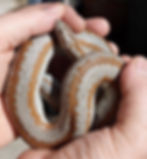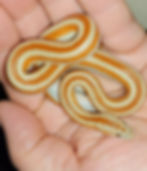

Herpetoculture



951.807.7598 (Text me before calling.)
This is going to be a busy breeding season for me. In the 2023 season I will be breeding two Tarahumara Mountain females (Boa sigma), Hypo Sonoran Boas, and Leopard Sonoran Boas (Boa sigma). Below is a list of rosy boa localities and morphs that I plan on producing. I have permits to breed, import, and export captive bred rosy boas and kingsnakes from California.
Locality Specific
1) Limberg Albino and Limberg Snow
2) Whitewater Albino
3) Normal Whitewater
4) San Felipe
5) Hypo San Felipe (Ghost Felipe)
6) San Matias
7) Bay of L.A.
8) San Markos Island
9) Magdalena Plains
10) Ortiz
11) Harquahala Mountains
Rosy Boa Morphs
1) Hypocabaxanthics (Cabazon Hypo X Pioneer Town Axanthic) - Limited Avail.
2) Pioneer Town Axanthic, Possible Het Hypo
3) Cabazon Hypo, Possible Het Axanthic
4) Possible Het Hypocabazanthic
5) Picasso and Het Picasso - Limited Avail.
6) Randy Wright's Golden Rosy Boa
7) Purple Albinos and Hets (Triv X Whitewater Albino)
Here is a link to Facebook to see my herpetology, herpetoculture, and field herping posts.




Rosy Boa
The Snake I Always Wanted
By Stephen Richardson
The Herping Bug
Growing up in the San Bernardino Mountains had its perks. I could walk a block or so and go trout fishing, catch frogs, snakes, and lizards, and enjoy some snow during the winter. My favorite time of year was in the spring and summer when the herps were out and active. I used to go hiking numerous times looking to catch lizards and snakes. My favorite catches were horned lizards and California king snakes. I can’t count how many gopher snakes and striped racers that I have caught over the years. Finding and catching snakes was a regular pastime for me growing up in the mountains. To this day I look up into the hills where ever I go and wonder what awesome herps reside under the rocks, stumps, and in the crevasses. I see the world through snakes; whenever somebody mentions a place I immediately think about what snakes live in the area. Hiking to find snakes (going herping), has always been an important part of my life experience; I now view it as an indispensable part of my life. I would not be happy if I could not get out into the field and look for these amazing slithering creatures.
Introduction to the Rosy Boa
I remember an afternoon when some of my neighborhood friends had a different looking snake that felt smooth and had an interesting pattern and coloration. I had the opportunity to hold it and experience the snake in a hands-on fashion. Wow, what a cool snake; it was docile, calm, and beautiful. The snake was a rosy boa. I immediately began to ask questions about the snake and where I might find one. I had to get a pet rosy boa! At this point in my life I had little money to spend and could not afford to travel to the place where my friend’s snake was collected. I was nowhere near old enough to drive. I looked in the mountains where I lived year after year for a rosy boa and never came upon one. Many years past and I discovered skateboarding, electric guitar, and other pastimes; yet I never left my passion for herping to far behind. In fact my passion for herps, to my wife’s dismay, reared its slithery body again after I finished college and became a full-time educator. Yes, I married my wife before I finished college; she was irresistible. My passion for herps exploded and I dabbled in many areas of herpetoculture, eventually focusing on snakes. Of course I began to buy and breed rosy boas. My wife bought me my first rosy boa, Lichanura trivirgata trivirgata. Presently, I keep and breed a large number of snakes with about two thirds of them consisting of the many localities and morphs of rosy boas. I only have a couple of rosy boas that I collected in the wild, one of which was rescued from the road after it had been hit by a car.
San Bernardino Mountains Rosy Boa
In July 2009 I found a small female rosy boa on my way home from teaching a night class. Finally, I found a boa in the San Bernardino Mountains. She had been hit by a car ever so slightly so I took her home and my daughter and I nursed her back to health. We treated her wounds and acclimated her to captivity. She immediately took to feeding on frozen thawed rodents and has since done great. My daughter named her Coasty and she now holds her a couple of times a week. Needless to say my daughter claimed Coasty as her pet, so she is officially my daughter’s rosy boa. In the spring of 2010 my wife found a large mature female rosy boa midday on the road. The boa would not leave the road so my wife relocated her some distance from the road. That same year I found two small rosy boas crossing the road late at night during some of the warmer late summer nights. I relocated these little ones so they were far from the road. I spent many hundreds of hours looking for boas as a kid; now that I am all grown up, I found three in the span of two years and the one rosy that was collected was claimed by my daughter. What a bum deal! I am glad she has a passion for herps.
Coasty was the only one of the four San Bernardino Mountain boas found by myself and my wife that was collected. I do have some strong opinions about collecting herps in the field. Thanks to the special permits given by the California Department of Fish and Game there are many breeders of rosy boas native to California, myself included, thus there are many easy to acquire captive bred rosy boas available. There is no need to collect wild rosy boas. Additionally, most of the localities of boas from Mexico and Arizona are readily available on the internet or at trade shows. It is my opinion, as responsible herpers, we should take advantage of the captive breeding efforts and leave the wild populations alone. There is nothing wrong with enjoying them in the field and snapping a few pictures; however, let the boa go back to being a boa in the wild and let it help the wild generations of boas continue on as they have for thousands of years.
My Rosy Boas
I am presently working with well over one hundred captive bred rosy boas with a couple of wild caught specimens. I purchased most of my boas from Randy Wright with a few trades happening here and there. I have some boas that were purchased from John Columbus with the rest being acquired from various sources. I have additionally kept some of my neonates over the years. Randy is a great herpetoculturist that has taught me many things about breeding and keeping rosy boas. He answers my questions no matter how many times I ask him the same questions; it takes time and repetition for things to sink in. I have a group of his golden rosy boas that I plan to work with in the future. That group reminds me of his many years of passion and commitment to the propagation of rosy boas. I know I will acquire more boas in the future to add my various projects; undoubtedly, many of the boas will come from Randy Wright. Currently, I am working on acquiring some of the more obscure or rare localities of boas.
The Future
Keeping and breeding rosy boas is one of the most rewarding and fascinating part of my herpetoculture hobby/business. I love working with my many rosy projects and have some bold future plans. I have the goal of becoming one of the most renowned rosy boa breeders in the United States. Hopefully comparable to herpers like Randy Wright, Randy Limburg, and many other pioneer breeders of the rosy boa. I recognize that much work has already been accomplished in the area of breeding rosy boas; however, I am committed to preserving the many localities and morphs that exist today. Perhaps In the future I will have something interesting to add to the hobby of breeding rosy boas. I just might have some secrets.
There are many localities of boas at risk because of habitat destruction or other ecology disruptions. Aside from my love of rosy boas, there is good reason to keep locality pure breeding groups of rosy boas. I am committed to keeping locality pure groups and providing neonates for sale for other rosy boa enthusiasts. With that being said, I now find myself involved is some freaky rosy boa projects. I had some strange projects offered to me and decided to go for it. I will focus on locality animals and preserve them; however, I am now involved is some freaky stuff. I will be working with rosy boas for many years and I look forward to sharing my boas with those that are interested. I regularly conduct educational presentations to elementary school kids, scouts, veterinarian technicians, and any of my students that are interested. I have some special boas that are used to educate many children and adults about their amazing ability to thrive in the lower elevations of California Mountains and in the Sonoran and Mojave deserts. Feel free to check out some of my rosy boas in my photo gallery and be sure to read my care sheet on rosy boas. I am a rosy boa fan for sure. Please share any interesting rosy boa stories or photos via e-mail.
